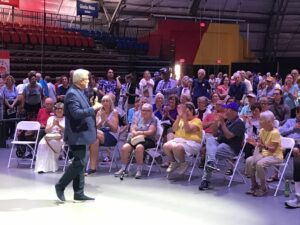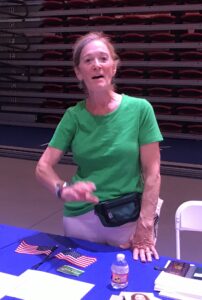City of Sarasota Commission candidates offer ideas to tackle affordable housing crisis.
By Johannes Werner
Original Air Date: Mar. 15, 2024
Host: Last weekend, Sarasota Democrats staged a one-ring circus for their candidates. Literally – at the Sailor Circus, the training venue for aspiring performers. Ringleader and unicyclists aside, the high-energy event also featured local artists with a rendition of “We Are Family”. With all City of Sarasota Democrats — both candidates and elected officials — in the same tent, our news team took advantage to find out about their ideas and plans regarding affordable housing.

School board candidate Tom Edwards ‘performs’ at the Sailor Circus.
Johannes Werner: Since the pandemic, Sarasota has quickly become one of the most unaffordable places when it comes to housing. In response, several measures are underway in the City of Sarasota. For one, the Sarasota Housing Authority has hundreds of new public-housing units in the pipeline, going up mostly in Newtown. In commercial construction, major change is afoot with new zoning corridors along three major thoroughfares, allowing developers higher density in return for attainable housing. City staffers are still in the process of refining details, and the city commission may vote on the measure April 1. And then, one neighborhood association, Park East, has triggered discussion about what’s called the “missing middle”, when it volunteered its neighborhood, just east of downtown, as a testing ground for an experiment allowing property owners to build more dwelling units per lot.

Kathy Kelley Ohlrich
We first asked Kathy Kelley Ohlrich — candidate for City Commission District 3, running against Erik Arroyo — what approaches she takes for affordable housing relief. She brought up the “Missing Middle” discussion at Park East.
“Maybe, after we get more data, we should be looking at it,” she said. While proponents say this will create more workforce housing, critics fear that allowing higher “Missing Middle” density will lead landlords to just create more short-term rentals for tourists.
Arroyo, her Republican opponent, represents the city on the Sarasota County Affordable Housing Advisory Committee, and he has suggested the city itself should be building workforce-priced apartments.
Meanwhile, two-term City Commissioner Jen Ahearn-Koch told us the pending corridor zoning amendments will need a fix, if they pass as currently proposed. The at-large commissioner was a forceful proponent of inclusionary zoning, which would have allowed the city to set specific requirements for developers. But that didn’t pass, as her colleagues preferred the incentive approach.
She has called the currently proposed minimum of 11.5% attainable units, in exchange for higher density, a “billion-dollar giveaway” that makes “the problem worse”.
” Think about it – what do we get in return?”, she told WSLR News. “Sarasota will be at the very low end of the range, and we will give three times the density. We’re off the range”.
Ahearn-Koch says she’s ready to work on a fix if other commissioners agree. She would ask for a higher affordable component – closer to the 20 to 25 percent other Florida cities are asking, grant just double density, at most, and include an extra compatibility requirement, as well as a sunset provision.
Ron Kashden is a candidate for District 2, where he’s running against fellow Democrat Liz Alpert. His main concern is about the building height the new corridor zoning would allow.

Kashden
Ron Kashden: You need one affordable house … housing unit for every 10 regular-price units. So that’s what Jen was upset about, and what a lot of people are upset about. It’s more than equilibrium, but just barely. And the problem with that is the way the zoning text amendment is structured. The developers get a lot for that little sliver beyond equilibrium.
JW: What do they get?
RK: Well, what they do get is additional density. They also get height, and that was one of the problems that I had with it particularly, in this zoning text amendment. And I’ve been advocating about this topic for a number of weeks, of months, because I think when they figured out the heights, they were incorrect. They’re incompatible with the surrounding neighborhoods. So I agree with Jen, that it seems that we’re getting too little to change our zoning. Plus, what changes that we’re giving looks like they could potentially be intrusive and not compatible with the surrounding neighborhoods. And so I’ve been advocating for a lower height. And fortunately, the planning department did hear my concerns and did put in a 70-foot height cap on all the corridors.
JW: He argues in favor of a higher affordable housing requirement.
RK: Yes, I would like to because the problem is the scale that we’re currently using, when it’s hard to even use the word ‘affordable’. If you notice, the city has pivoted to ‘attainable’, because it clearly isn’t affordable. When you consider ‘affordable’ housing for a family that earns over $100,000 a year, it starts stretching that term. So that’s why they reach to ‘attainable’. And it gets back to the problem, you know, we really do have to focus on affordable housing rather than attainable housing.
JW: Incumbent Liz Alpert has voted in favor of the proposed corridor zoning change. Staffers have argued developers might not engage if the city were to ask for a higher affordable component.
Asked what he thinks about the Sarasota Housing Authority’s ambitious construction projects at Newtown, he said this:
RK: There are a lot of tools at the city’s disposal. Certainly, helping funding the Public Housing Authority, you get a lot of bang for your buck. But we can also leverage the wonderful financing that the city has, and the low bond rates that the city has, that we could help fund either the purchase of land for fully affordable housing or similar projects that don’t particularly target a specific neighborhood that clearly causes concern.
JW: Kashden also believes more tweaks could be made to single-family neighborhood zoning.
RK: When it’s zoned as just single-family residential, while that may be good in some parts of the city, that’s problematic in other ways. Because what happens is, they tear down an old house and build a McMansion, because economically that makes sense. So the best way to stop that is by empowering the developers for better form factors and, absolutely, there is a lot of tools.
JW: What kind of tools?
RK: Trying to get people aware of what [additional dwelling units] are and the benefits behind that. Right then and there, you can, without harming the surrounds and making a project or a site incompatible with its surroundings, you can put a second dwelling unit there. Laurel Park is .. unique in that it allows the rental of the primary house and the secondary ADU.
JW: Sarasota City Commission elections are non-partisan.
This has been Johannes Werner, reporting for WSLR News.
WSLR News aims to keep the local community informed with our 1/2 hour local news show, quarterly newspaper and social media feeds. The local news broadcast airs on Wednesdays and Fridays at 6pm.